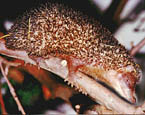|
Greater
Hedgehog Tenrec
(Setifer setosus) |
||||
|
|
Physical
characteristics and distribution
|
|
Head
and body length is 150-220 mm and tail length is 15-16 mm. Weights
in the wild have been recorded between 180 and 270 gms. The
entire upper portion of S. setosus is covered with sharp,
bristly white-tipped spines that even cover the small tail projection.
The muzzle, limbs and underside are covered with soft, scanty
hair, and are buffy, dark brown, or whitish. The white-tipped
spines on the upper parts of the body create a mottled effect,
with underlying colors ranging from comparatively pale to black.
The hind limbs are slightly longer than the forelimbs, and all
digits are well developed. Females have five pair of mammae.
They are found in all latitudes and phytographic zones: eastern humid forest, central highlands, northern highlands, sambirano, western deciduous forest, and spiny bush in Madagascar. |
|
Description
of the brain
|
|
Animal
source and preparation
|
|
All specimens collected followed the same preparation and histological procedure.
|
Other
Related Resources (websites and publications)
List of Specimens | Explore Collections | Brain Sections | Brain Evolution | Brain Development | Brain Circuitry | Brain Functions | Location and Use | Related Web Sites | Contact Us | Search MSU Database | Personnel | Home



